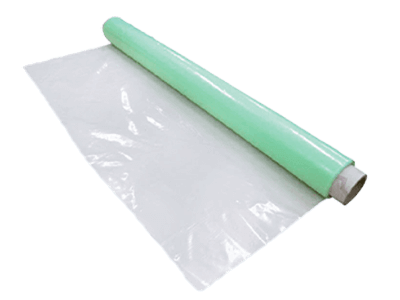What Is an Airtight Sheet?

An airtight sheet is a residential plastic-based moisture-proof film used to construct the airtight layer of a moisture-proof, airtight construction, such as a house.
It plays a role in preventing indoor air and moisture from moving to the exterior wall. During construction, it is important to use sheets in such a way as to minimize the number of seams.
Airtight sheets that have passed tests for moisture permeability, strength, durability, and tearing strength with tacker nails have been certified.
In addition to airtight sheets, other types of airtight materials include plastic moisture-proof film for housing, moisture-permeable waterproof sheets, plywood, gypsum board, and plastic insulation materials (foamed plastic heat insulators).
Uses of Airtight Sheets
Airtight sheets are used in different ways depending on the type of insulation method. The types and uses of airtight sheets are as follows:
1. Filling Insulation Method
In the filling insulation method, insulation is used in the gaps between columns, beams, and other spaces in the wall. Fiber-based insulation materials (glass wool, rock wool, etc.) are used in this method.
Since moisture reduces its effectiveness, airtight sheets (moisture-proof film) are applied to the interior side of the insulation material and moisture-permeable waterproof sheets are applied to the exterior to make it airtight and prevent condensation.
2. Exterior Insulation Method
In the exterior insulation method, insulation is used on the outside of the pillar and beam framework. In this method, plastic insulation (in board form) is used. To make it airtight, airtight sheets may be installed, joints may be treated with airtight tape, or a combination of both may be used.
If there are joints in the airtight sheet, airtight tape, airtight gaskets, or other airtight aids are used to ensure that the airtight sheet is not severed at any point.
Principle of Airtight Sheets
Airtight sheets play a role in reducing the ingress of water vapor from the room into the wall, protecting the airtight environment and building materials from condensation, and improving dew-proofing performance. When installing a damp-proof, airtight sheet, a damp-proof, airtight sheet is installed on the interior side. It is important to create an unbroken boundary between spaces.
In addition to securing an overlap of 30 mm or more between the airtight sheet and the ceiling and walls, the airtight sheet should be held in place by fastening it with a tacker, sandwiched with a holding material, or fastened with airtight tape. Insulation construction is basically divided into “moisture-proof layer,” “air-proof layer,” and “ventilation layer” from the interior side.
The airtight sheet is installed under the interior material of the “moisture-proof layer.” The unit for moisture permeability of an airtight sheet is [m2-s-pa/ng], and the higher the value, the less moisture will pass through. The material composition of airtight sheets can be a single film made of a single plastic material or a composite film made of a single film combined with a film or plastic with different properties.
Variable airtight sheet, also called moisture-tight sheet or moisture control sheet, is characterized by its ability to change its resistance to moisture permeability in response to ambient humidity, allowing moisture to permeate into the room. This prevents summer condensation from occurring due to moist air outside the room caused by the temperature difference between the air-conditioned room and the outside air in the summer.
Other Information on Airtight Sheets
Disadvantages of Airtight Sheets
Airtight sheets are an important material for making a house highly airtight and insulated to achieve a high-performance house. However, there are some disadvantages associated with the installation of airtight sheets.
1. Condensation Forms Inside the Walls
When installing airtight sheets, it is necessary to work carefully to completely eliminate any gaps. This is because even a small gap will allow moisture to enter the wall.
Once moisture enters, it cannot move out of the wall because of the airtight sheet. As a result, condensation will form inside the walls and mold will grow on the insulation and other materials.
Mold inside the walls not only corrodes the pillars and beams but also deteriorates the insulation, so care must be taken. Since earthquake resistance and insulation performance will deteriorate, it is important to install airtight sheets so that there are no gaps.
2. Air Tends to Be Trapped
If a lot of sunlight shines into the house in the summer, the airtight sheet prevents hot air from escaping, and the inside of the house may become hot. When odors occur, it is easy for the odors to become trapped. In addition, heaters that emit exhaust into the room, such as oil heaters, are dangerous because they produce carbon monoxide.
Under these conditions, windows must be opened for ventilation, but the performance of airtightness and insulation is reduced, and the benefits of high-performance housing are dampened. Therefore, the key to maintaining a comfortable life in a house with airtight sheets is to use air conditioning effectively and efficiently to ventilate the house.